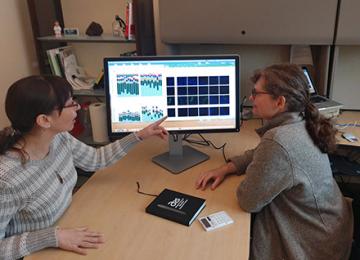Insights into Diet, Gut Bacteria, and Chronic Diarrhea

ARS scientists Danielle Lemay (right) and Zeynep Alkan review microscope images and data from SAMSA2 software. (ARS photo)
Gut health. It’s making headlines these days. And with good reason. Did you know that there are trillions of microbes in your gut? All those microbes—mainly bacterial species—are constantly acting and interacting in ways that can either help or harm us. The question researchers are asking is “How, exactly?”
A recent study by Agricultural Research Service (ARS) researchers and scientists from the University of California-Davis provides some insight.
Gut bacteria and nutrition are inseparable, says molecular biologist Danielle Lemay, with ARS’s Western Human Nutrition Research Center in Davis, California. Gut bacteria aid nutrient absorption, while nutrients influence which gut bacteria live and die. Together they promote health or disease.
Lemay and her team studied gut bacteria in rhesus macaque monkeys, who can suffer from a diarrheal disease similar to ulcerative colitis in humans. All the monkeys in the study—healthy and sick—were fed the same diet. This made it easier to study whether their gut microbes responded differently to the same foods. The team used a new method called “SAMSA2,” which they developed, to observe all genes expressed by all organisms—bacteria, fungi, protists—in fecal samples from healthy monkeys and from those with chronic diarrhea.
Even though all the monkeys consumed the same foods, this study showed that the “diet” of their gut microbes was not the same, Lemay said. Gut microbes can consume carbohydrates contained in the foods we eat or produced by our intestinal cells. Gut microbes in the diseased animals expressed more genes that enabled them to consume more of the carbohydrates produced by intestinal cells. That was a problem because those carbohydrates also form a protective layer of mucin over the intestinal cells, and too much degradation of the layer enables microbes to cross the intestinal barrier.
Another critical discovery was that the identity of a particular bacterium is not as important as what it is doing in the gut. For example, the pathogen Campylobacter was found in both groups, but in the diseased animals, the pathogen expressed a gene that allowed it to attach to the mucin layer. In healthy animals, Campylobacter may just pass through, Lemay says.
These study findings, published in Microbiome in 2019, could have implications for chronic gastrointestinal diseases, such as ulcerative colitis, that affect humans.—By Sue Kendall, ARS Office of Communications.
You May Also Like

